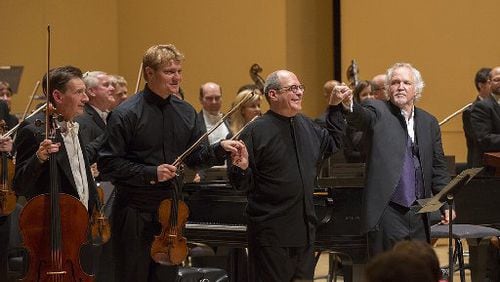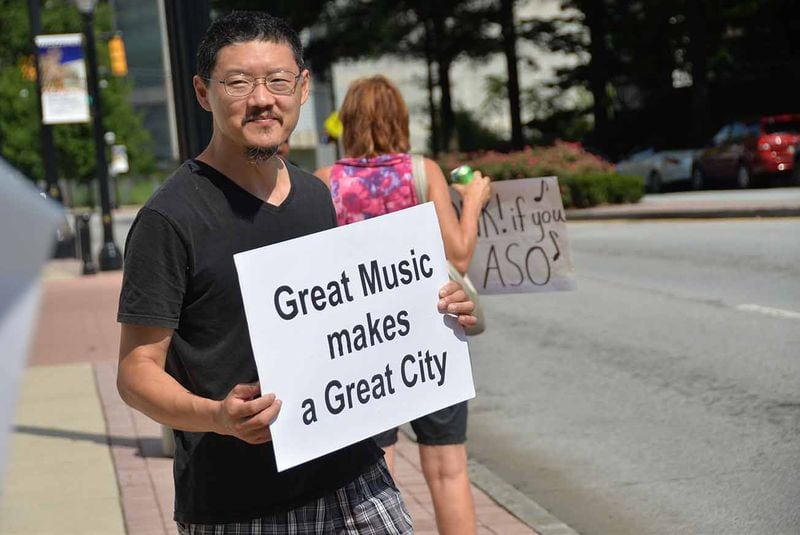After 10 months of thorny labor contract negotiations between Atlanta Symphony Orchestra management and musicians, including a two-month player lockout, a resolution seems at hand.
Members of the ASO Players' Association, the musicians' union, were summoned to an informational meeting Friday morning. The musicians are believed to have voted on terms negotiated during federally mediated sessions Wednesday and Thursday with the team representing ASO and Woodruff Arts Center management.
If the majority of players vote to approve the deal over a 24-hour period ending Saturday morning, it would immediately go to the Woodruff's governing board for final approval, probably as soon as Saturday afternoon.
A spokesman for ASO and Woodruff management and a Players' Association leader declined comment Friday.
In late September, management cancelled the initial eight performances of the orchestra's 70th anniversary season, through this week. And, with concerts scheduled to start up again on Nov. 13 and 15, the administrators were expected to cancel anything from one week's performances to several weeks if the two sides didn't finally reach a collective bargaining agreement this week. Until recent days, December's slate of holiday concerts even appeared at risk.
Music director Robert Spano was to have lead the orchestra and ASO chorus in Ralph Vaughan Williams’ “A Sea Symphony” next week. But a Woodruff spokesperson said this week that a different program (to be announced) would have to be substituted if the concert goes forward since there won't be sufficient time to rehearse such a major choral work.
The two sides began discussing a new contract some 10 months ago. When a deal was not reached when the 2012 collective bargaining agreement expired at midnight Sept. 6, management was quick to lock out the players for the second time in two years.
No talks were held until both sides agreed to bring in Federal Mediation and Conciliation Service mediators on Oct. 7. Though the mediators don't have the power to force either side to accept terms, they can nudge compromise little by little. Both sides have praised the work of Allison Beck, acting director of the Federal Mediation and Conciliation Services, and Virginia-based mediator Richard Giacolone, who has conducted the last two rounds of mediation solo.
The thorniest issue has been the size of the orchestra going forward. The musicians' full-time ranks were trimmed from 95 to 88 and salaries cut by an average of 15 percent in 2012 negotiations. When the ASO ran up its 12th consecutive year of deficits in fiscal 2014 (finishing $2 million in the red), leadership sought additional trims to the "complement."
In its Oct. 24 proposal, management held that the number of full-time musicians for the 2014-15 season should be cut from 88 to the 76 players who remain (after defections, retirements and deaths). It said it would launch a major fund-raising campaign to endow musician chairs with the goal to rebuild the size of the orchestra up to as many as 90 players. That pledge, however, was not promised as part of the proposed four-year contract.
The ASO Players’ Association countered on Oct. 27 with a proposal of starting with 77 players and increasing the ranks incrementally to a minimum of 88 by the end of the 2017-18 season. The musicians are determined that required positions for the final two years be included in the contract.
Credit: hpousner
Credit: hpousner
"The issue of complement is and has been contractual for decades, just as a fixed complement is for every major American orchestra in their respective contracts," Players' Association president Paul Murphy told the AJC before mediation resumed Wednesday. "We are asking nothing except to retain our fixed complement of 88 in the contract and ask for best efforts to exceed that number as we try and climb back to our long-standing complement of 95 musicians."
The musicians have said repeatedly throughout negotiations that further cuts to their ranks, requiring extensive use of part-time and fill-in players, would be a major setback to the sound of the 27-time Grammy-winning orchestra.
Pay was the other issue needing resolution this week. Before talks resumed, management had not changed its offer of 4.5 percent raise over the four years. The musicians had moved from proposing a 15 percent raise to one closer to 10 percent.
Even by the rough-and-tumble standards of many labor negotiations, this one has been harsh, garnering national and international headlines, reflecting poorly on arts support in Atlanta. Early in the lockout, the musicians began issuing a stream of statements that accused management of poor stewardship, mismanagement and even malfeasance. Their supporters continue to post charges on social media that the Woodruff, which files a single difficult-to-dissect tax return for its administration and four divisions (the ASO, Alliance Theatre, High Museum and Arts for Learning) annually, is covering up its own financial issues while blaming the musicians.
Woodruff leaders strongly defend their stewardship and have said that foundations, corporations and individual donors will provide more support ifor the ASO f they can make the orchestra live within its budget ($37 million in fiscal 2014) and halt the red ink.
It can be taken as another sign of progress in the negotiations that the Players' Association has been relatively restrained in official statements and comments in recent weeks.
Come back to the Arts & Culture blog for AJC updates on the ongoing negotiations.
ATLANTA SYMPHONY TIMELINE
May 31, 2o12: After 10 consecutive years of operating deficits, the ASO's accumulated debt rises to $23 million, including $18 million borrowed against earnings on the orchestra's endowment.
Aug. 25, 2012: Musicians are locked out by ASO management, seeking significant concessions, when the sides are unable to reach a collective bargaining agreement.
Sept. 26, 2012: After a month without pay and benefits, players agree, with great rancor, to a $5.2 million wage reduction over two years (an average of $14,000 annually for each) and a cut in the orchestra's size from 95 to 88 full-time musicians. The 2012-13 season starts on time.
Nov. 26, 2013: Moody's Investors Service downgrades the Woodruff's credit outlook from stable to negative. "The negative outlook is based on the deficit operations of the center and challenges presented by the symphony division," it says in its report.
May 31, 2o14: Orchestra finishes the 2014 fiscal year with a $2 million operating deficit on a budget of $37 million, its 12th consecutive year of red ink. Seeking to ease the financial pressure, the ASO and Woodruff's boards agree to treat the $18 million borrowed against the ASO endowment as a distribution. That reduces orchestra's accumulated debt to $5 million owed the Woodruff.
Sept. 7: After eight months of contract talks with minor progress, management locks out players for the second time in two years.
Sept. 22: With no negotiations for two weeks, management cancels the first eight concerts of the 70th anniversary season, through Nov. 8.
Credit: hpousner
Credit: hpousner
Sept. 24: Music director Robert Spano tells The New York Times: "This is a dire and critical juncture for the city of Atlanta, which is in danger of losing the flagship of its culture. If the 10th-largest urban economy in America is incapable of sustaining its cultural jewel, what does that signal about our country?"
Sept. 11: ASO Players' Association issues statement charging, "The Symphony has been placed in the position of turning deficits that have been engineered by the WAC with the intention and for the purpose of extracting more concessions from the Orchestra's musicians."
Sept. 29: ASO President and CEO Stanley Romanstein resigns, saying in a statement that he doesn't want to be an "impediment" to management reaching a labor agreement with musicians.
Oct. 4: Responding to allegations by the musicians and their supporters of mismanagement and malfeasance, Woodruff governing board chairman Douglas Hertz tells the Atlanta Journal-Constitution, "It makes you wonder, you know, are we supporting a bunch of crazy people." Musicians issue statement that Hertz is more interested in the bottom line than in "preserving the high artistic standards of the institution he has a duty as a steward to serve and protect" and that he's willing to "'break the backs of employees."
Oct. 7: Mediators with the U.S. Federal Mediation and Conciliation Service restart talks for the first time since the lockout began.
Nov. 6: Tentative accord reached.
Nov. 7: Musicians vote on deal, which, if approved, goes to the Woodruff governing board for final approval.
About the Author








